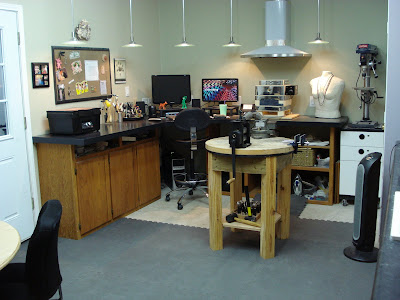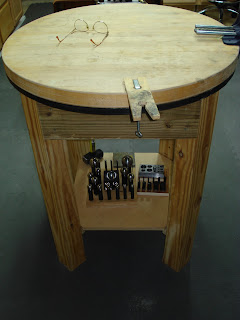I haven't posted in a while - there are just not enough hours in a day! After work each day and on the weekends for the last several months I have been finishing up some areas in my studio and changing some things to suit my current needs. A while back I realized that I had to do something to change the path I was on. I had been experiencing this overwhelming sense of loneliness while working in my studio, and had lots of tools that were often sitting unused. I decided it was time to quit feeling sorry for myself and do something about it, so I made a plan to open my studio for beginning and intermediate level jewelry/metalsmithing workshops a few Saturdays each month. I posted an ad about it on Ganoksin's Orchid Forum, received several emails from interested people, and have already given one workshop! It has been wonderful making contact with likeminded creative people and has gotten me out of my creative rut! This new plan has also provided me with the motivation I needed to get all the unfinished studio construction projects completed like texturing and painting the walls in the shop area. As a result of my new plans, I also created new projects like the need to reconfigure the studio area to accommodate more people, and building an area for soldering. Unfortunately, this new plan called for moving the desk/home office area, that my husband had gotten in the habit of using, out of my studio. My poor husband feels like he has gotten the "boot", but was willing to move in the name of progress!!!
We moved all of our home files, office supplies, and my husband's computer out of the studio to a small bedroom upstairs, and moved the cabinets that he had been using as a desk into the shop area to create some soldering stations. This freed up one side of the studio so that I could create a work/seating area for my workshops. It was a lot of work, but I think it came out great! My husband has taken the move in stride. He has turned his new space into a really nice office, and is enjoying the view from the second story window!
BEFORE - My husband's office space in the corner of my studio.
AFTER - New seating area in the same corner of my studio.
In this new space I put some bookshelves below the existing wall cabinets. I made the bookshelves from a single tall bookcase that I cut in half with a piece of countertop material across the top. Then I purchased a new piece of galvanized steel from a really nice guy named Ed at a local sheet metal shop and mounted it on the wall for a backsplash beneath the wall cabinets. The steel backsplash is perfect to use with magnets for dispaying photos of students and their work. On the other wall I hung an old pegboard that was left over from the garage before it became my studio. For the seating area I built a round table from 3/4" plywood with threaded steel pipe legs, and bought four new armless office chairs. The aluminum ducting that you see at the top of the photo is a new addition as well. We added on to the ducting that we had previously installed for the air conditioning and passed it through the wall into the newly finished shop area.
MORE "AFTER" PHOTOS!
The door going into the newly finished "shop" area.
Two new soldering stations in the shop area with exhaust system.
(These are the cabinets that we moved from my husband's desk area of the studio.)
Full view of the newly installed exhaust system
(awkward looking, but very effective!)
This is the right hand side of shop area with polishing wheel,
Potter USA hydraulic presses, bending brake, and belt/disc sander.
The wire butterfly on the wall was made by my oldest daughter for a
fairy costume that she wore to a Halloween party. I think it is a beautiful
piece of art and it makes me so happy to have it hanging in my studio!
A close-up view of my two Potter USA hydraulic
presses that were built by Kevin Potter.
I LOVE THEM !!!
The larger press is powered by a compressor
which is hidden in the cabinet below.
These are my Potter USA hydraulic press accessories!
Pancake dies, silhouette dies, synclastic and anticlastic
bracelet formers,and extra platens and pushers.
I love these, too!
The left side of the shop area is my new personal bench area!
The large piece of artwork on the wall is a collage that my youngest daughter and I made when she was about 14 or 15. It is made from pictures of flowers, beautiful gardens, and other peaceful scenes cut from magazines and applied to a piece of plywood with modge podge. It makes me really happy to have it over my bench area!
The newly installed air conditioning ducting for the shop area!
The studio area is pretty much the same.
The sink area is the same, no changes.







































